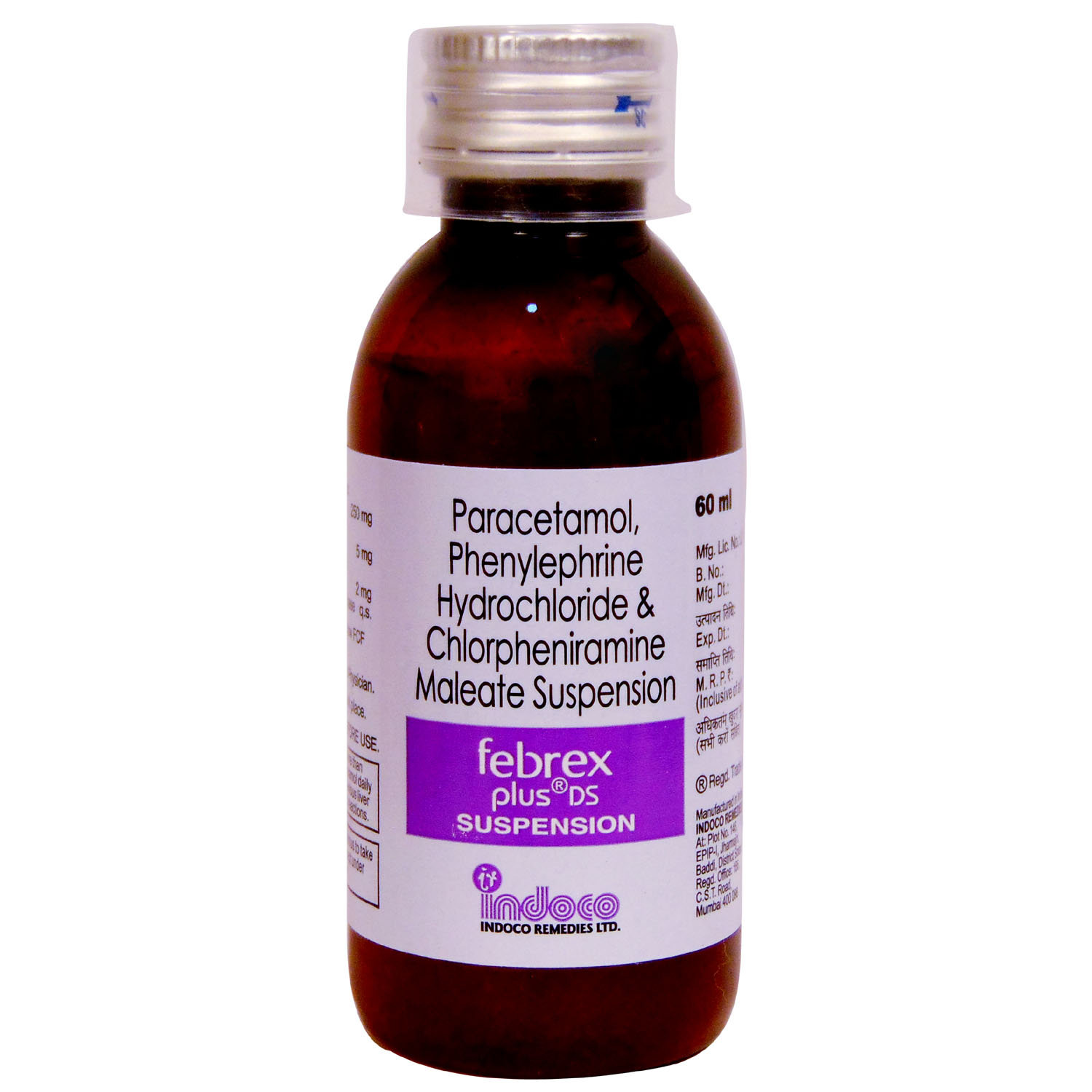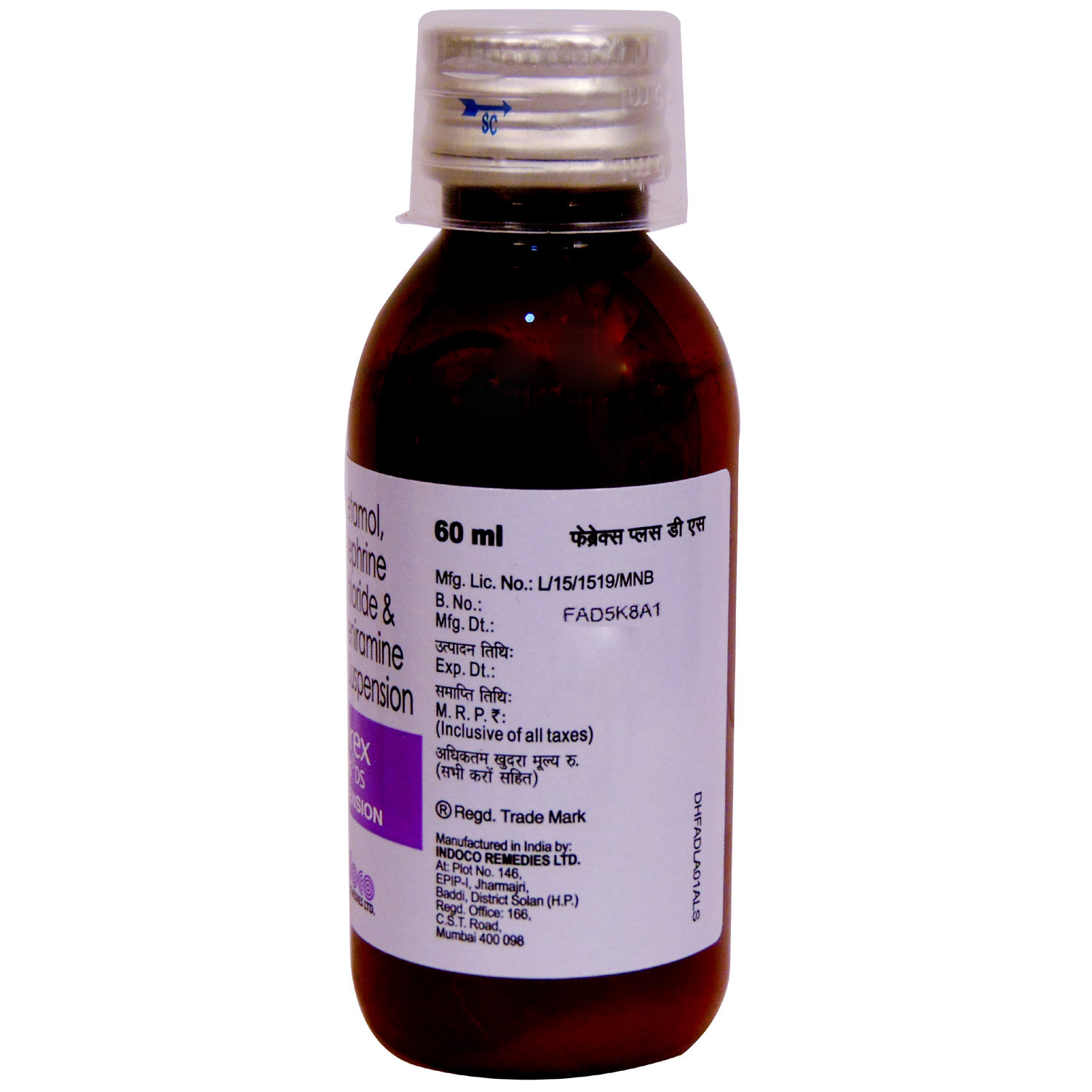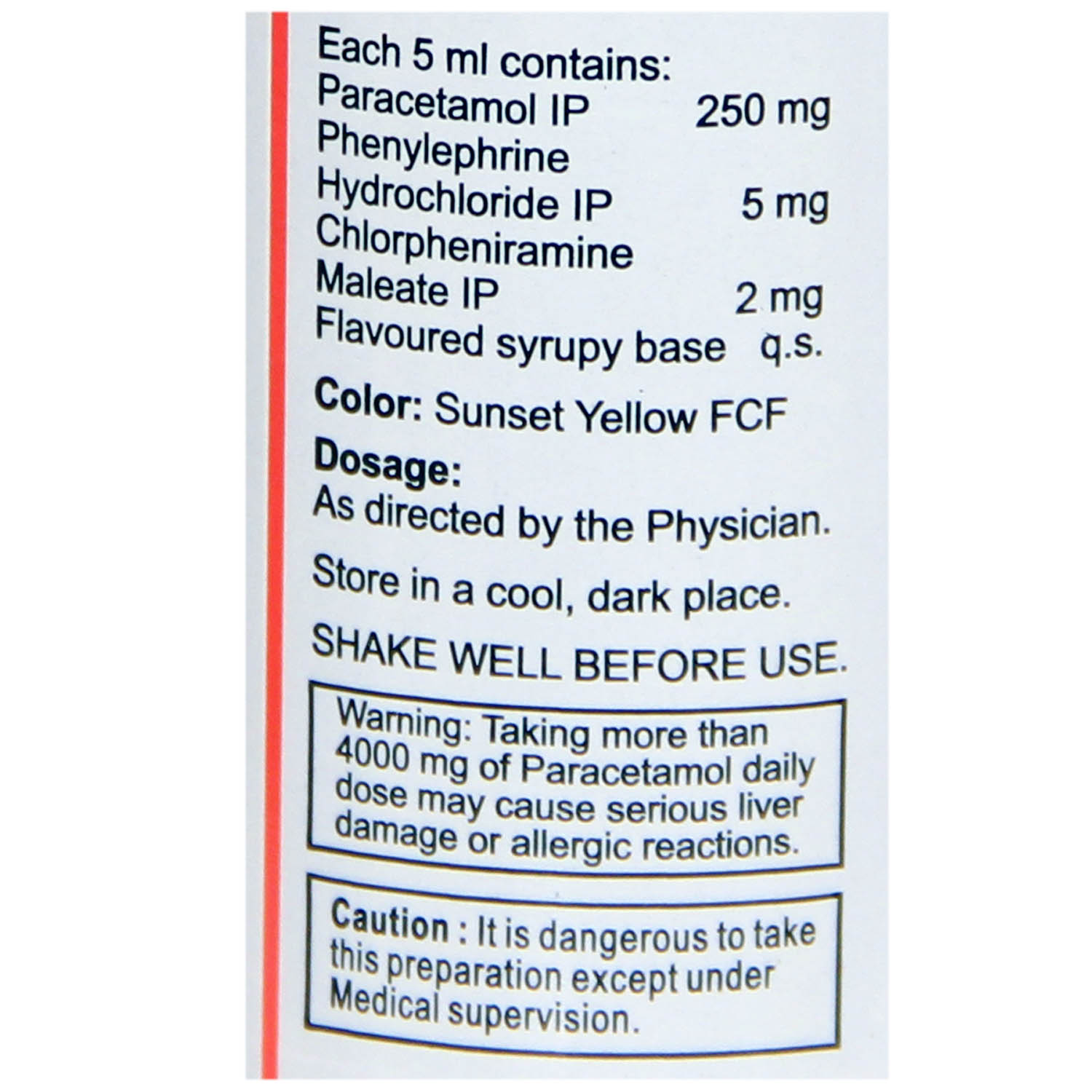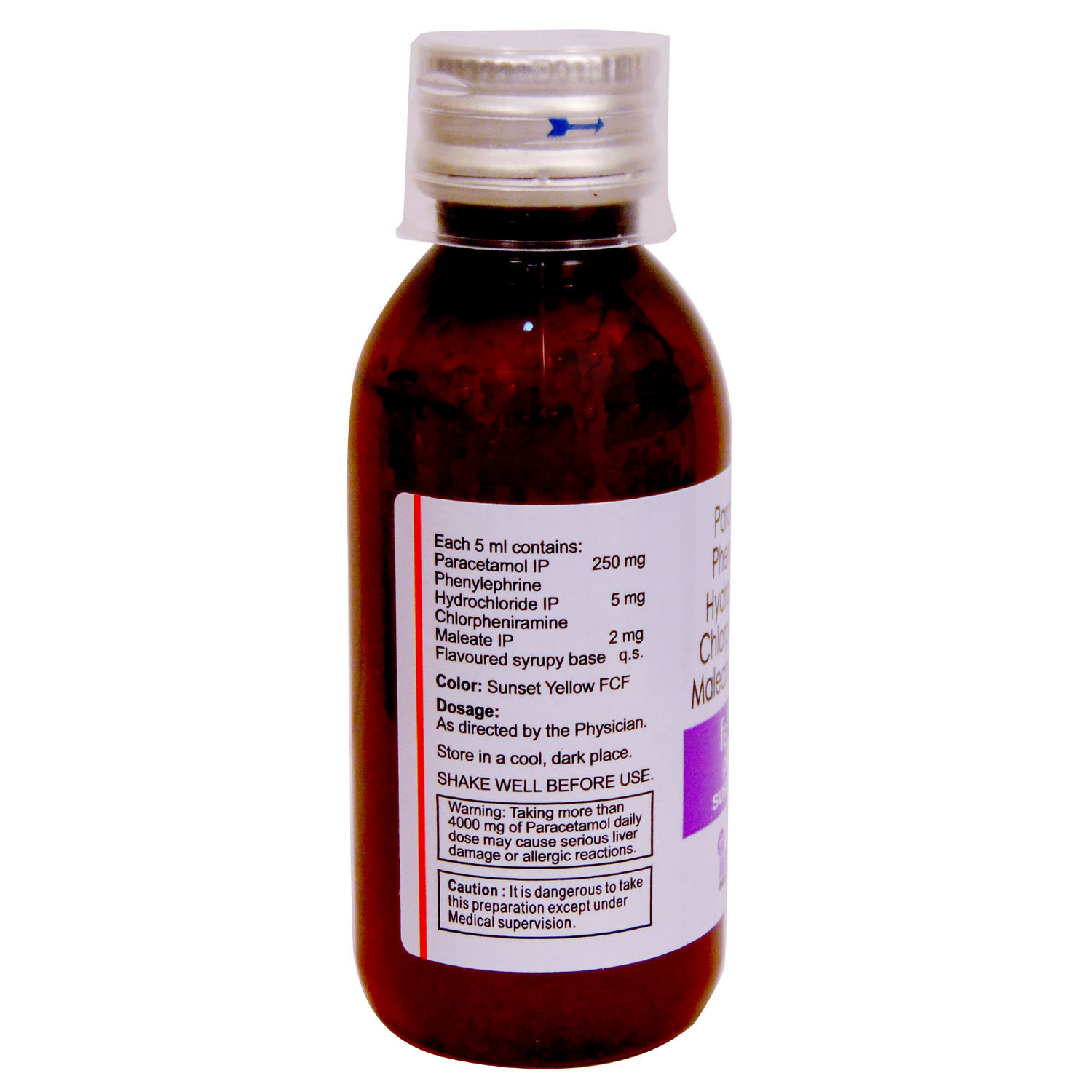Febrex Plus DS Suspension 60 ml








MRP ₹111
(Inclusive of all Taxes)
₹16.6 Cashback (15%)
Provide Delivery Location
Online payment accepted
 Prescription drug
Prescription drugWhats That
Manufacturer/Marketer :
Consume Type :
Expires on or after :
Return Policy :
About Febrex Plus DS Suspension
Febrex Plus DS Suspension belongs to the class of medication called 'cough and cold medications' primarily used to treat symptoms of the common cold and allergies like sneezing, runny/stuffy nose, fever, headache, body pains, congestion, or watery eyes. The common cold is a respiratory illness affecting the nose and throat. It is mostly caused by viruses known as 'rhinovirus'. The virus enters the body through the nose, mouth, or eyes and spreads easily through droplets in the air when the person who is sick sneezes, coughs, or talks.
Febrex Plus DS Suspension is a combination of three drugs, namely: Paracetamol (mild analgesic and antipyretic), Phenylephrine hydrochloride (decongestant), and Chlorpheniramine maleate (antihistamine/antiallergic). Paracetamol works by inhibiting the production of certain chemical messengers in the brain known as prostaglandins responsible for pain and fever. Phenylephrine hydrochloride works by shrinking the blood vessels in the nasal passage. Thereby providing relief from congestion and decreasing excess mucus production. Chlorpheniramine maleate works by blocking the action of histamine, a substance responsible for causing allergic reactions. It helps to provide relief from symptoms of allergy.
Take Febrex Plus DS Suspension as prescribed. Your doctor will recommend how often you need to take Febrex Plus DS Suspension based on your medical condition. Some people may experience drowsiness, nervousness, headache, dizziness, insomnia (difficulty falling or staying asleep), blurred vision, constipation, and dry mouth. Most of these side effects of Febrex Plus DS Suspension do not require medical attention and gradually resolve over time. However, if the side effects persist or worsen, please consult your doctor.
If you are allergic to Febrex Plus DS Suspension or any other medicines, please tell your doctor. If you are pregnant, it is advised to inform your doctor before using Febrex Plus DS Suspension. Do not use Febrex Plus DS Suspension if you are breastfeeding without a doctor’s advice, as it may be excreted in breast milk and cause harm to the baby. Febrex Plus DS Suspension is not recommended for children below 4 years. Please do not take more than the prescribed dose of Febrex Plus DS Suspension as it may cause liver damage.
Uses of Febrex Plus DS Suspension
Directions for Use
Key Benefits
Febrex Plus DS Suspension contains Paracetamol, Phenylephrine hydrochloride, and Chlorpheniramine maleate. Paracetamol is a mild analgesic (relieves pain) and antipyretic (reduces fever) that works by inhibiting the production of certain chemical messengers in the brain known as prostaglandins that are responsible for pain and fever. Phenylephrine hydrochloride is a decongestant that works by contracting and narrowing the blood vessels. Thereby, providing relief from congestion and decreasing mucus production. Chlorpheniramine maleate is an antihistamine (anti-allergic drug) that works by blocking the action of histamine, a substance responsible for causing allergic reactions. It helps to provide relief from symptoms of allergy such as sneezing, running nose, watery eyes, itching, swelling, and congestion or stiffness.
Storage
- Get urgent medical help if you notice abnormal lung sounds with symptoms, like bluish skin, flare-ups of your nostrils, or trouble breathing.
- If you have asthma or allergies, managing these conditions with inhalers and bronchodilators can help prevent abnormal lung sounds.
- Infections may need antibiotics or breathing therapy to help open your airways and make breathing easier.
- Wash your hands regularly and take other steps to avoid getting sick and spreading germs.
- Doing breathing exercises can help improve your lung function and make breathing easier.
- Contact your physician right away if you suffer from hypoxia symptoms including chest pain, disorientation, or shortness of breath.
- Your doctor can monitor your progress and modify treatment programs with the help of routine follow-up sessions.
- Omega-3 supplements may support the transport of oxygen to tissues.
- Regular exercise improves cardiovascular health and boosts oxygen delivery to tissues.
- Quit smoking, as it can worsen hypoxia.
Drug Warnings
If you are allergic to Febrex Plus DS Suspension or any other medicines, please tell your doctor. If you are pregnant, it is advised to inform your doctor before using Febrex Plus DS Suspension. Do not use Febrex Plus DS Suspension if you are breastfeeding without a doctor’s advice as it may be excreted in breast milk and cause harm to the baby. Febrex Plus DS Suspension is not recommended for children below 4 years. Please do not take more than the prescribed dose of Febrex Plus DS Suspension as it may cause liver damage. If you have high blood pressure, diabetes, glaucoma, hyperthyroidism (overactive thyroid), chronic bronchitis, asthma, chronic obstructive pulmonary disease (COPD), blockage in the stomach or intestines, enlarged prostate gland, pheochromocytoma (tumour in the adrenal glands), kidney, liver, heart or urinary problems, inform your doctor before taking Febrex Plus DS Suspension.
Drug-Drug Interactions
Drug-Drug Interactions
Login/Sign Up
Taking Febrex Plus DS Suspension 60 ml with Propofol may lead to increased levels of Febrex Plus DS Suspension 60 ml leading to side effects like high blood pressure.
How to manage the interaction:
Taking Febrex Plus DS Suspension 60 ml with Propofol is not recommended, but it can be taken if prescribed by the doctor. Do not discontinue the medications without consulting a doctor.
Taking Furazolidone with Febrex Plus DS Suspension 60 ml can cause an increase in high blood pressure.
How to manage the interaction:
Taking Furazolidone with Febrex Plus DS Suspension 60 ml is not recommended, it can be taken if prescribed by the doctor. However, if you experience sudden and severe headache, blurred vision, confusion, seizures, chest pain, nausea or vomiting, sweating, lightheadedness, fainting, sudden numbness or weakness (especially on one side of the body), speech difficulties, fever, consult the doctor immediately. It is advised to use Febrex Plus DS Suspension 60 ml only after 14 days of stopping Furazolidone.
Co-administration of Febrex Plus DS Suspension 60 ml with Sevoflurane can increase the levels of Febrex Plus DS Suspension 60 ml and lead to side effects.
How to manage the interaction:
Taking Febrex Plus DS Suspension 60 ml with Sevoflurane is not recommended, it can be taken if prescribed by the doctor. Do not discontinue the medications without consulting a doctor.
Taking Tranylcypromine with Febrex Plus DS Suspension 60 ml can increase the risk of high blood pressure.
How to manage the interaction:
Taking Tranylcypromine with Febrex Plus DS Suspension 60 ml is not recommended, but can be taken together if prescribed by a doctor. However, consult a doctor if you experience severe headache, blurred vision, confusion, seizures, chest pain, nausea or vomiting, sudden numbness or weakness (especially on one side of the body), speech difficulties, fever, sweating, lightheadedness, and fainting Do not discontinue any medications without consulting a doctor.
Co-administration of Selegiline with Febrex Plus DS Suspension 60 ml together can raise blood pressure.
How to manage the interaction:
Taking Selegiline with Febrex Plus DS Suspension 60 ml is not recommended, it can be taken together if prescribed by a doctor. However, consult a doctor immediately if you experience any symptoms such as severe headache, blurred vision, confusion, fits, chest pain, nausea or vomiting, sudden numbness or weakness (especially on one side of the body), speech difficulties, fever, sweating, lightheadedness, and/or fainting Do not discontinue any medications without consulting a doctor.
Taking Febrex Plus DS Suspension 60 ml and Potassium citrate (in tablet or capsule form) together can increase the risk of stomach ulcers, bleeding, and gastrointestinal injury.
How to manage the interaction:
Taking Febrex Plus DS Suspension 60 ml with Potassium citrate is not recommended as it can lead to an interaction, it can be taken if prescribed by the doctor. However, if you experience any symptoms such as severe stomach pain, bloating, lightheadedness or dizziness, nausea, vomiting (especially with blood), decreased hunger, or dark, tarry stools, consult the doctor immediately. Do not discontinue any medications without a doctor's advice.
Taking Febrex Plus DS Suspension 60 ml and Potassium chloride (in tablet or capsule form) together can increase the risk of stomach ulcers, bleeding, and gastrointestinal injury.
How to manage the interaction:
Taking Febrex Plus DS Suspension 60 ml with Potassium chloride it not recommended as it can lead to an interaction, it can be taken if your doctor has prescribed it. However, if you experience any symptoms such as severe stomach pain, bloating, lightheadedness or dizziness, nausea, vomiting (especially with blood), decreased hunger, or dark, tarry stools, consult the doctor. Do not discontinue any medications without a doctor's advice.
Co-administration of Topiramate can cause increased body temperature and decreased sweating, and these effects may be worsened when combined with medications like Febrex Plus DS Suspension 60 ml.
How to manage the interaction:
Although there is a possible interaction between Febrex Plus DS Suspension 60 ml and Topiramate, you can take these medicines together if prescribed by your doctor. However, if you experience any unusual symptoms, consult the doctor. Do not discontinue any medications without consulting a doctor.
Co-administration of Febrex Plus DS Suspension 60 ml with Halothane may increase the risk of an irregular heart rhythm.
How to manage the interaction:
Although taking Febrex Plus DS Suspension 60 ml with Halothane together can result in an interaction, it can be taken if a doctor has prescribed it. However, if you experience any symptoms like lightheadedness, fainting, irregular heart beat, dizziness, consult the doctor. Do not discontinue any medications without a doctor's advice.
Co-administration of Nortriptyline with Febrex Plus DS Suspension 60 ml may lead to side effects like increased blood pressure.
How to manage the interaction:
Although taking Nortriptyline and Febrex Plus DS Suspension 60 ml together can result in an interaction, it can be taken if a doctor has prescribed it. Regular monitoring of blood pressure is advised. Do not discontinue any medications without a doctor's advice.
Drug-Food Interactions
Drug-Food Interactions
Login/Sign Up
Diet & Lifestyle Advise
- Wash your hands with soap and water regularly to prevent the spread of germs.
- Eat plenty of foods rich in good bacteria like yoghurt to improve overall health.
- Drink plenty of fluids to avoid dehydration.
- Gargle with salt water for relief from sore throat.
- Avoid consumption of alcohol with Febrex Plus DS Suspension as it may cause tiredness, drowsiness, or lack of concentration.
Side Effects of Febrex Plus DS Suspension
- Drowsiness
- Nervousness
- Headache
- Dizziness
- Insomnia (difficulty in falling or staying asleep)
- Blurred vision
- Constipation
- Dry mouth
Habit Forming
Therapeutic Class
All Substitutes & Brand Comparisons
RX
Stelofen Butter Scotch Flavour Suspension 60 ml
Stelios Pharmaceuticals Llp
₹42
(₹0.63/ 1ml)
62% CHEAPERRX
Out of StockSkycold 250/5/2 Suspension 60Ml
Skymax Laboratories
₹65
(₹0.98/ 1ml)
41% CHEAPER
Product Substitutes
Author Details
We provide you with authentic, trustworthy and relevant information
Drug-Diseases Interactions
Drug-Diseases Interactions
Login/Sign Up
FAQs
Febrex Plus DS Suspension contains Paracetamol, Phenylephrine hydrochloride, and Chlorpheniramine maleate. Paracetamol works by inhibiting the production of certain chemical messengers in the brain known as prostaglandins that are responsible for pain and fever. Phenylephrine hydrochloride works by contracting and narrowing the blood vessels. Thereby, providing relief from congestion and decreasing mucus production. Chlorpheniramine maleate works by blocking the action of histamine, a substance responsible for causing allergic reactions.
Febrex Plus DS Suspension contains paracetamol which acts as a mild pain killer (analgesic) and fever reducer (antipyretic). It works by inhibiting the production of certain chemical messengers in the brain known as prostaglandins responsible for pain and fever.
Febrex Plus DS Suspension may cause drowsiness. It is not necessary for everyone taking Febrex Plus DS Suspension to experience this side effect. Therefore, avoid driving or operating heavy machinery if you feel drowsy after taking Febrex Plus DS Suspension.
You are not recommended to take Febrex Plus DS Suspension with Cetirizine as co-administration of these two medicines may increase sedation and can cause drowsiness, dizziness and difficulty in concentrating. However, please consult a doctor before taking Febrex Plus DS Suspension with other medicines.
You are not recommended to stop taking Febrex Plus DS Suspension without consulting your doctor as it may worsen the condition or cause recurring symptoms. Therefore, take Febrex Plus DS Suspension for as long as your doctor has prescribed it, and if you experience any difficulty while taking Febrex Plus DS Suspension, please consult your doctor.
Do not use Febrex Plus DS Suspension if you have used an MAO inhibitor in the past 14 days, like isocarboxazid, linezolid, phenelzine, rasagiline, selegiline, or tranylcypromine. Tell your doctor before taking Febrex Plus DS Suspension if you have nausea, stomach pain, itchy skin, loss of appetite, dark urine, clay-coloured stools, or jaundice (yellowing of your skin or eyes). In rare cases, paracetamol present in Febrex Plus DS Suspension may cause a severe skin allergic reaction. So, if you observe any skin blisters or redness or rash, stop taking Febrex Plus DS Suspension and contact your doctor.
Drug-Drug Interactions Checker List
- DIPHENHYDRAMINE
- CETIRIZINE
- DULOXETINE
- ESCITALOPRAM
- CLONAZEPAM
- ALPRAZOLAM
- CYCLOBENZAPRINE
- DEXTROMETHORPHAN
- ALBUTEROL
- PARACETAMOL
- IBUPROFEN
- RAMELTEON
Special Advise
- Do not give Febrex Plus DS Suspension to children below 4 years of age.
- Do not take Febrex Plus DS Suspension for longer than 7 days in a row (for adults) and 5 days (for the children above 4 years).
- If you have allergic skin reactions like skin redness or rash that spreads and causes blistering and peeling, immediately contact a doctor.
Disease/Condition Glossary
Common cold: The common cold is an infection caused by the virus, mainly known as ‘rhinoviruses’ affecting the nose and throat (upper respiratory tract). Children younger than 6 years are at the most significant risk of colds, but healthy adults can also be affected to have 2-3 colds annually. In most cases, cold symptoms are recovered within a week or ten days. However, symptoms might last longer in people who smoke or are exposed to allergens like pollutants, dust, etc. The symptoms of the common cold include sneezing, sore throat, cough, congestion, mild body pains, low fever, mild headache, feeling unwell, stuffy, or runny nose. In some cases, the discharge from the nose may become thicker and yellow or green, which is not an indication of bacterial infection.
Allergies: It occurs when allergy-causing agents (allergens) attack and invades our body thereby causing the release of histamines. This chemical messenger 'histamine' causes swelling, inflammation, redness, itchiness, itchy/watery nose, and watery eyes. Allergies generally occur due to chemicals, air pollution, pet danders, dust, pollen hairs, seasonal allergies like hay fever, etc.

Have a query?
Buy best Anti Allergic Drugs products by
Cipla Ltd
Micro Labs Ltd
Sun Pharmaceutical Industries Ltd
Alkem Laboratories Ltd
Mankind Pharma Pvt Ltd
Dr Reddy's Laboratories Ltd
Lupin Ltd
Leeford Healthcare Ltd
Abbott India Ltd
Intas Pharmaceuticals Ltd
Glenmark Pharmaceuticals Ltd
Morepen Laboratories Ltd
Alembic Pharmaceuticals Ltd
Aristo Pharmaceuticals Pvt Ltd
East West Pharma India Pvt Ltd
Hetero Drugs Ltd
Torrent Pharmaceuticals Ltd
Systopic Laboratories Pvt Ltd
Zydus Cadila
Ajanta Pharma Ltd
Canixa Life Sciences Pvt Ltd
FDC Ltd
Macleods Pharmaceuticals Ltd
Zuventus Healthcare Ltd
Hegde & Hegde Pharmaceutica Llp
Kivi Labs Ltd
Koye Pharmaceuticals Pvt Ltd
Medishri Healthcare Pvt Ltd
Rapross Pharmaceuticals Pvt Ltd
Sanofi India Ltd
Unison Pharmaceuticals Pvt Ltd
Wockhardt Ltd
Biochem Pharmaceutical Industries Ltd
Elder Pharmaceuticals Ltd
Indoco Remedies Ltd
Fourrts India Laboratories Pvt Ltd
Zydus Healthcare Ltd
Amwill Healthcare Pvt Ltd
Bayer Pharmaceuticals Pvt Ltd
Corona Remedies Pvt Ltd
Indiabulls Pharmaceuticals Pvt Ltd
Ipca Laboratories Ltd
Klm Laboratories Pvt Ltd
Olcare Laboratories Pvt Ltd
Talent India Pvt Ltd
Zee Laboratories Ltd
Auspharma Pvt Ltd
Biocute Life Care
Cadila Healthcare Ltd
Dolvis Bio Pharma Pvt Ltd
Entod Pharmaceuticals Ltd
Indchemie Health Specialities Pvt Ltd
Levin Life Sciences Pvt Ltd
Med Manor Organics Pvt Ltd
Pristine Pearl Pharma Pvt Ltd
Rockmed Pharma Pvt Ltd
Troikaa Pharmaceuticals Ltd
Uniza Healthcare Llp
Cadila Pharmaceuticals Ltd
Capital Pharma
Cnx Health Care Pvt Ltd
Eumedica Pharamceuticals
Galcare Pharmaceuticals Pvt Ltd
GlaxoSmithKline Pharmaceuticals Ltd
Knoll Healthcare Pvt Ltd
Medgen Drugs And Laboratories Pvt Ltd
Oaknet Healthcare Pvt Ltd
Seagull Pharmaceutical Pvt Ltd
Skn Organics Pvt Ltd
Unipark Biotech Pvt Ltd
Akumentis Healthcare Ltd
Apex Laboratories Pvt Ltd
Atopic laboratories Pvt Ltd
Aurz Pharmaceutical Pvt Ltd
Biophar Lifesciences Pvt Ltd
Delcure Life Sciences Ltd
Eris Life Sciences Ltd
Gladstone Pharma India Pvt Ltd
Heal (India) Laboratories Pvt Ltd
Inex Medicaments Pvt Ltd
Keimed Pvt Ltd
Kepler Healthcare Pvt Ltd
Lividus Pharmaceuticals Pvt Ltd
Monichem Healthcare Pvt Ltd
Nova Indus Pharmaceuticals
Psychotropics India Ltd
RPG Life Sciences Ltd
Rnd Laboratories Pvt Ltd
SMG Global Pharma
TTK Healthcare Ltd
Vasu Organics Pvt Ltd
Votary Laboratories (India) Ltd
Yaher Pharma
Yuventis Pharmaceuticals
Acclimate Life Sciences
Bioceutics Inc
Biochemix Health Care Pvt Ltd
Brinton Pharmaceuticals Ltd
Chlorophyll Pharmaceuticals
DR Johns Lab Pharma Pvt Ltd
Alcohol
Safe if prescribed
Avoid consumption of alcohol with Febrex Plus DS Suspension as it may increase the risk of liver damage and cause increased drowsiness, dizziness or difficulty in concentrating. Please consult a doctor before consuming alcohol with Febrex Plus DS Suspension.
Pregnancy
Consult your doctor
The safety of Febrex Plus DS Suspension in pregnant women is unknown. Therefore, it is given to pregnant women only if the doctor thinks benefits outweigh risks.
Breast Feeding
Consult your doctor
Febrex Plus DS Suspension may be excreted in breast milk and cause harm to the baby. Besides this, Febrex Plus DS Suspension may also slow the milk production, so it is better to contact a doctor before a lactating mother takes it.
Driving
Safe if prescribed
Febrex Plus DS Suspension may cause blurred vision or impair thinking in some people. Therefore, drive only if you are alert after taking Febrex Plus DS Suspension.
Liver
Consult your doctor
Take Febrex Plus DS Suspension with caution, especially if you have a history of Liver diseases/conditions. The dose may be adjusted by your doctor as required.
Kidney
Consult your doctor
Take Febrex Plus DS Suspension with caution, especially if you have a history of Kidney diseases/conditions. The dose may be adjusted by your doctor as required.
Children
Safe if prescribed
Febrex Plus DS Suspension is not recommended for children below four years of age. However, please consult a doctor before giving Febrex Plus DS Suspension to children.





_0.jpg?tr=q-85)
